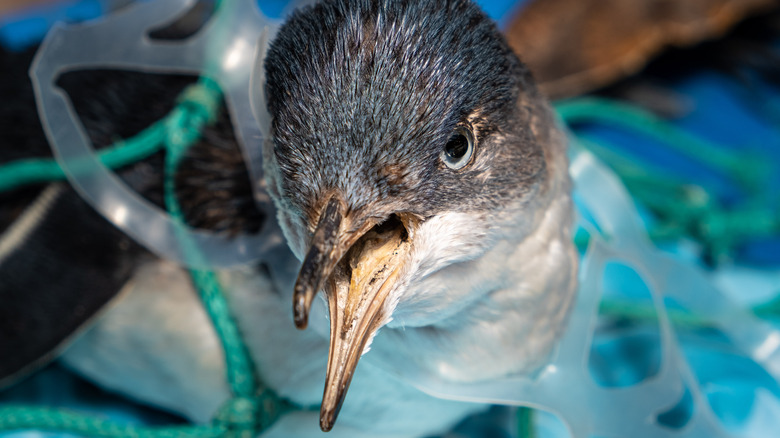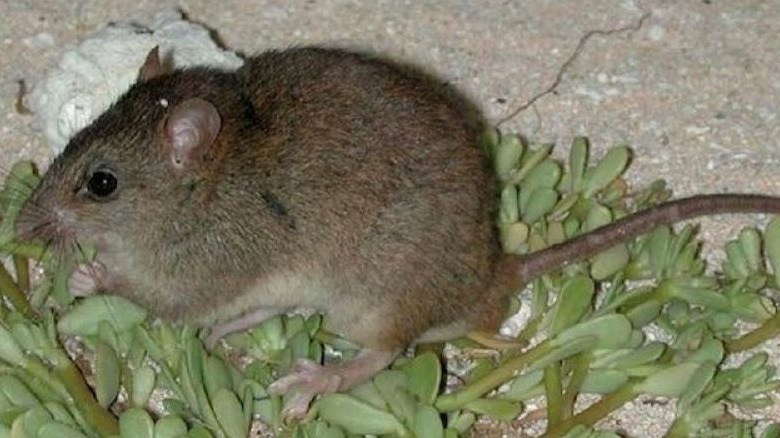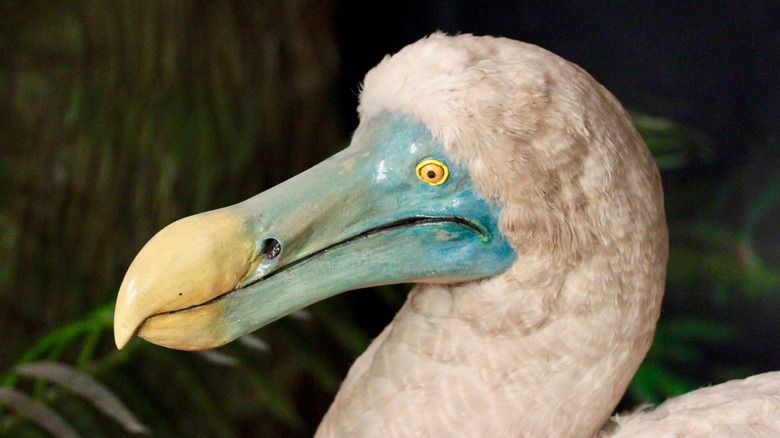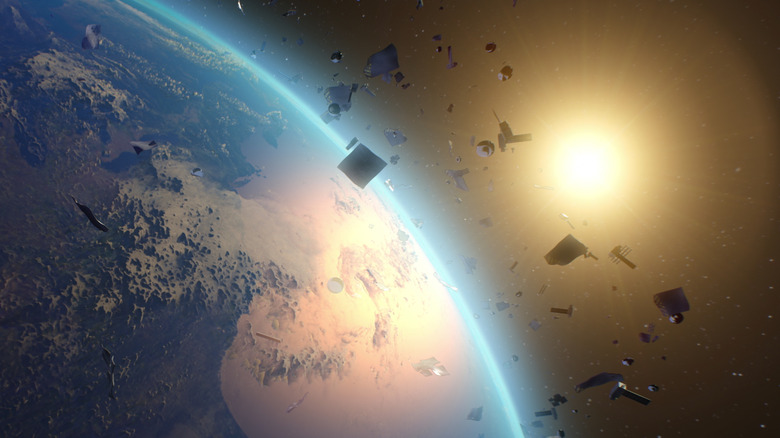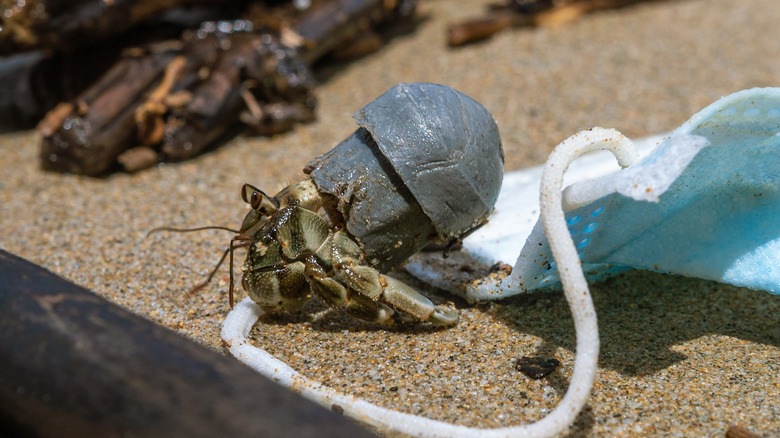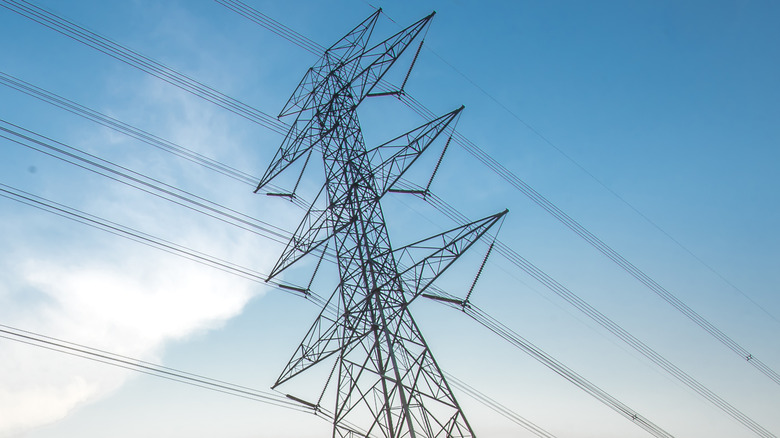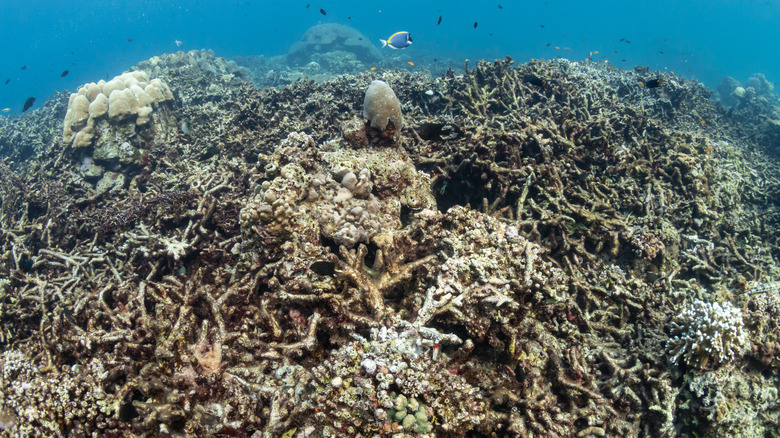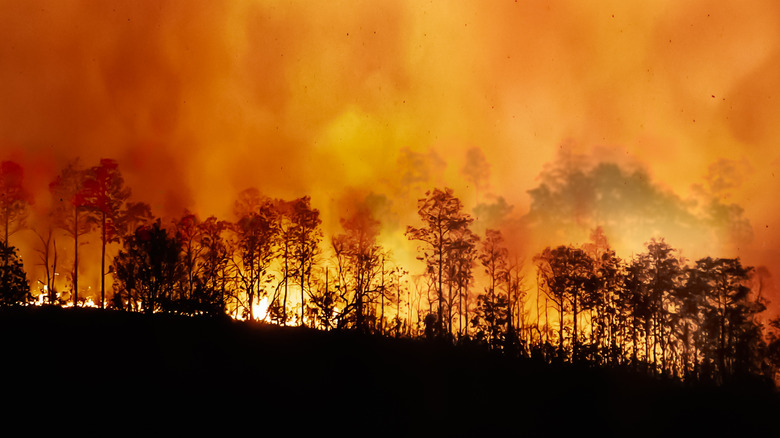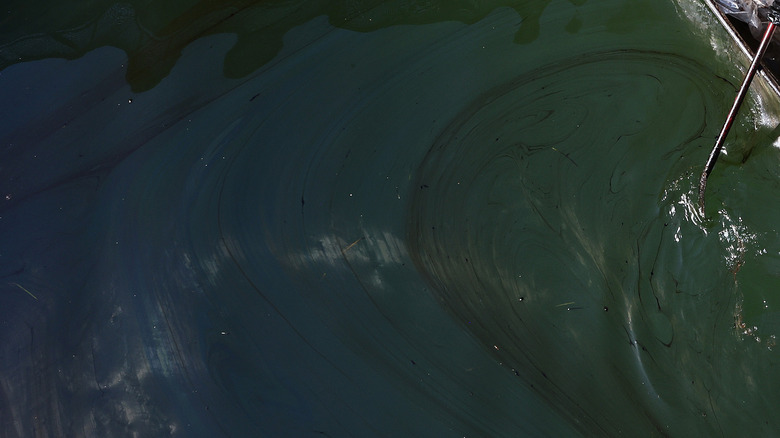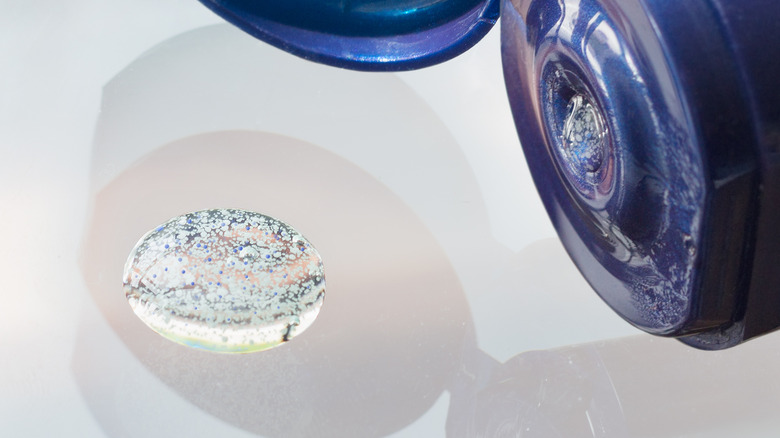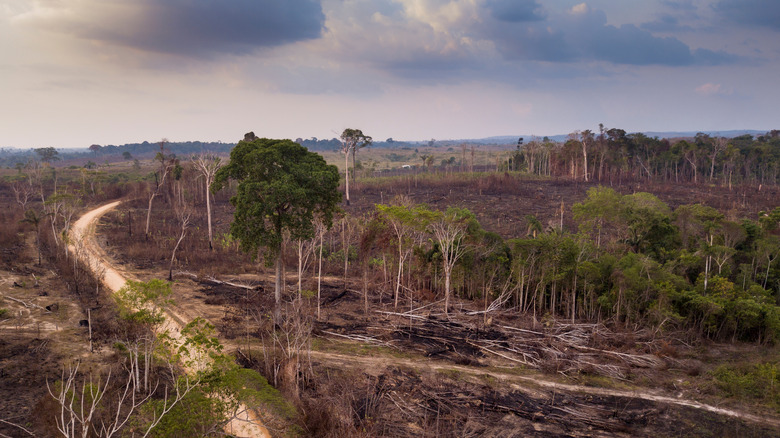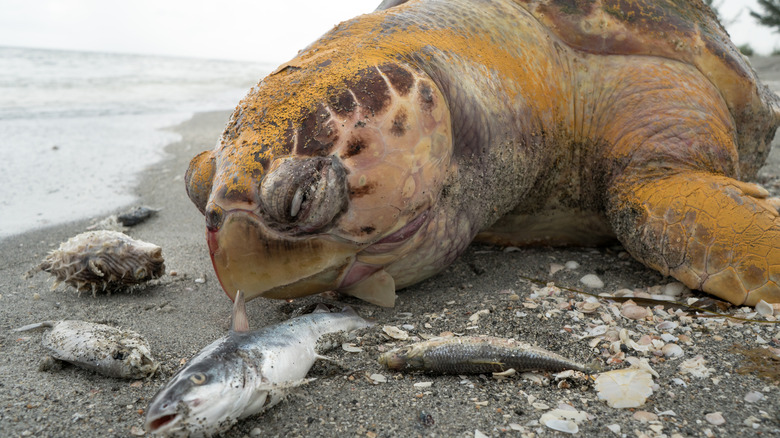The Worst Ways Humans Have Impacted Nature
It's a message that has been repeatedly smashed over humanity's collective head for the past few decades: Despite being such an insignificant species, Homo sapiens is easily one of, if not the most destructive creatures that has ever lived on Earth. According to a 2018 study published in the Proceedings of the National Academy of Sciences, the world's population of nearly 8 billion human beings only accounts for about 0.01% of all life on the planet. However, humanity has been responsible for (or has at least had a hand in) the extermination of about 50% of all plants and 83% of all animals.
That said, the existence of humans isn't the problem. It's the actions and decisions that humans have made since the dawn of civilization, many of which failed to take into account their consequences and impacts on the environment. From leaving pollutants in the ocean that threaten the lives of marine organisms to wanton natural resource exploitation, humanity's pursuit of a comfortable tomorrow severely affects the quality of life of other living things — not just today, but possibly for decades to come.
In order to mitigate or even undo the damage humanity has brought upon Earth and its denizens, it's important to identify the worst ways humans have impacted nature. Here are just a few examples.
A mammal went extinct due to man-made climate change
At the northern end of Australia's Great Barrier Reef sits a small island called Bramble Cay. Though well-known as a breeding place for sea turtles, one species has become synonymous with the island itself in recent years. Smaller than an open palm, the reddish-brown fur and scaly, prehensile tail of the Bramble Cay melomys mean that it's more endearing than your average house rat. Bramble Cay is the only place where it has ever been found. Sadly, it's also a species that the world will never see again, because it's the first mammal to become extinct due to climate change (via National Geographic).
According to Britannica, cays are small, low-elevation islands made up of coral, rock, or sand. In these cases, rising sea levels due to man-made climate change bring massive flooding. The rush of seawater is more than enough to wash away plants, destroy natural structures, and even drown small animals. Bramble Cay sits above sea level by only less than ten feet. Since 2004, the island has lost over nine-tenths of its vegetation due to flooding. The loss of their primary food source and constant destruction of their homes devastated the Bramble Cay melomys population; the last time they were seen in the wild was in 2009, hiding under a dug-out canoe (per The Washington Post).
Australian scientists confirmed its extinction in 2016, noting that the consequences of man-made climate change were the most likely reason it was wiped out.
Humans (and invasive species) may have hunted the dodo to extinction
With its rather comical appearance and ridiculous-sounding name, the dodo bird is perhaps one of the most famous examples of animals that went extinct during man's reign on Earth. This flightless avian species was endemic to Mauritius, a small island nation under the Mascarenhas Archipelago (or Mascarenes) in the Indian Ocean (via Business Insider). According to Nature, the white-feathered, flightless bird was last seen alive during the late 17th century.
The American Museum of Natural History perhaps sums it up best: Ever since Dutch soldiers first stumbled upon the dodo bird in the 1600s, its population began to steadily decline over the course of 80 years due to the destruction of its natural habitat and excessive hunting, both by the humans themselves and the invasive species that hitched a ride on their ships (such as cats, dogs, pigs, and rodents, per World Atlas).
Further proof of this is the fact that based on 8,000 years' worth of climate data, the dodo bird was actually one of numerous species in Madagascar and the Mascarenes whose populations withstood "repeated megadroughts" across thousands of years (per ABC News). The 2020 study, which was published in Science, also stated that a "major increase in human activity" exacerbated the already delicate state of the dodo bird's continued survival, which was already threatened by severe climate stress.
Humans are leaving trash in space
Space exploration has always been an exciting frontier for humanity in general. After all, you don't have to be an astrophysicist or a NASA employee to develop an appreciation for space and the wonders it holds. Advancements in space science have also led to many practical benefits for humanity, such as improved disaster response, technological and infrastructure development, better weather forecasting, and enhanced agricultural production (via FlipScience). Unfortunately, the race to send expensive gear up into space means that humanity is also inadvertently creating a metal junkyard-slash-cage around the planet — one that might stay up there for centuries or even millennia.
The Natural History Museum defines space debris or space junk as anything from detached rocket parts to decommissioned satellites that end up floating in low Earth orbit (at least 160 km above Earth, per the European Space Agency). These errant parts and particles either outlived their usefulness or came into existence completely by accident (for instance, paint chips or nuts and bolts that somehow fell off a rocket).
According to National Geographic, space debris can zip around at over 22,300 mph, which is enough for even small pieces to cause great damage to large structures in space like the International Space Station. Based on recent estimates, there are at least 3,000 dead satellites, 34,000 bits of debris less than 4 inches in size, and an innumerable quantity of even smaller pieces that are flying around Earth at incredibly high speeds.
Hermit crabs are mistaking plastic trash for shells — and dying as a result
The indiscriminate disposal of small pieces of plastic may not seem like such a big thing for some. Unfortunately, irresponsible waste disposal can have serious ecological consequences. An astounding number of organisms in marine ecosystems have died because of plastic waste ending up where it shouldn't be: around the necks of seabirds and sea turtles, in the stomachs of whales, and even on the backs of hermit crabs (via The Washington Post).
Some hermit crabs find themselves settling into plastic bottle caps, which is a disturbingly tragic sight (via Business Insider). The real problem begins, however, when the hermit crabs make their way through plastic bottles and end up being trapped inside. Unable to get out, they eventually starve to death. Worse, upon a hermit crab's death, its body releases a chemical signal that inadvertently attracts other hermit crabs to the same death trap. In one particularly disturbing case, scientists found the remains and shells of 526 hermit crabs inside a bottle (per the National Resources Defense Council).
According to scientists, over 500,000 hermit crabs from the Cocos Islands in the Indian Ocean and the South Pacific Ocean's Henderson Island have died as a direct result of being trapped in plastic trash. And those are just two areas: As researcher Jennifer Lavers from the University of Tasmania put it: "A lot of places where you have crabs and debris, this is probably happening."
Humanity's reliance on electricity has taken a toll on the environment
It's hard to imagine what the modern world would be like without electricity. So much of today's innovations and technologies rely heavily on electrical power. However, as electricity propels society's progress, it also has more undesirable impacts on nature than the average person would imagine.
According to the World Nuclear Association, using any form of primary energy to generate electricity for public use will have "some environmental effect, and some risk." The United States Environmental Protection Agency proceeds to list down some of these environmental effects, adding that while virtually every component of the electricity system has potential environmental impacts, their degree and severity depend on how the electricity is produced. Some of the effects include the release of pollutants into bodies of water, the creation of solid waste products (including some that could be toxic to various organisms), greenhouse gas emissions, and the depletion of land and water resources to fulfill critical electricity generation functions.
Moreover, even the physical structures that enable electricity to reach different locations present a hazard to wildlife. Per Science Daily, avian electrocution via power lines is "a major threat to many bird species across the world," which is compounded by the fact that the highest observed incidences of electrocuted birds tend to involve individuals from species with dwindling numbers. Birds may also collide with power lines mid-flight, which also endangers their lives.
Coral reefs are dying
As FlipScience explains, coral reefs form when colonies of polyps (typically hundreds or thousands in a group) deposit calcium carbonate under their bodies. The resulting hard structure serves as a haven for marine life, as well as an anchor point for marine ecosystems: Not only do they provide a physical shelter for various plants and animals underwater, but they also enable nutrient recycling and sustain the lives of many organisms. That's why it would be such a big blow if nearly all of the world's coral reefs were to suddenly die out — and based on experts' findings, this could very well happen before the 22nd century arrives.
Nutrient-producing algae called zooxanthellae thrive in coral reefs, while they sustain the reef and give it its color. This mutually beneficial system gets disrupted, however, when water temperatures rise beyond livable conditions due to the increase of carbon dioxide absorbed by the oceans from the atmosphere. This causes corals to expel their zooxanthellae, which turns the corals white (in an event called bleaching) and eventually kills them (per Forbes).
According to Science Daily, coral reefs worldwide are continually threatened by rising ocean temperatures, different types of pollutants being dumped into the oceans, and destructive fishing practices. It's worth noting that all of these are connected to mankind's activities — and if the world continues to leave these unchecked, it could lose up to 90% of all of its coral reefs within the next two decades.
A gender reveal party burned nearly 23,000 acres of forest
It's important to understand that wildfires, in general, aren't necessarily bad for nature. In fact, wildfires that start with lightning strikes and other natural occurrences are essential for certain species to thrive due to the benefits they provide (via National Geographic). For starters, they help control insect populations and curb the spread of plant diseases, and also generate the heat that certain tree cones need to disperse their seeds. Additionally, wildfires clear dead trees and shrubs, making way for new ones to grow in their place.
However, due to the rapidly changing climate, woodland areas have become increasingly susceptible to wildfires, with the wildfires themselves becoming more destructive and harder to control (via ABC News). And of course, there's the issue of wildfires caused by humans, which are particularly tragic when they start from unnecessarily dangerous activities.
In 2020, a family held a gender reveal party at the El Dorado Ranch Park by the San Bernardino Mountains. Unfortunately, the celebration quickly went downhill when a smoke-generating pyrotechnic device inadvertently set dry grass on fire. The flames quickly spread due to a combination of extreme heat and strong winds. Over the course of 23 days, the wildfire torched nearly 23,000 acres of forest, forcing nearby residents to evacuate and causing thirteen injuries and one death (per InciWeb).
An oil spill killed potentially millions of wildlife
Oil spills happen when damaged oil rigs leak large amounts of oil into the ocean. The immediate and long-term impacts of such incidents on the environment tend to be devastating: the deaths of countless flora and fauna, the introduction of pollutants in the water that affect its overall quality, and the disruption of the water's pH/salinity levels that make it unsuitable for life (via Sciencing). According to Statista, oil spills used to happen far more often in the 1970s (about 20 every year) than they did in the 2010s (one to two per year). Despite being less frequent, however, oil spills are no less dangerous when they do happen — and one of the most recent examples had consequences that lasted for over a decade.
In 2010, the BP Deepwater Horizon drilling rig in the Gulf of Mexico exploded, leaking over 130 million gallons of oil (per National Geographic). It has the dubious distinction of being not only the largest oil spill in United States waters but also one of the world's most terrible environmental disasters. Oil spilled across the immensely biodiverse gulf for nearly three months, potentially causing the deaths of millions of marine organisms. About a decade after the oil spill, its effects were still observed in surviving populations of dolphins, seabirds, sea turtles, and other species. For instance, bottlenose dolphins registered higher rates of lung, cardiac, and reproductive issues, as well as increased susceptibility to stress.
Facial washes are dumping microscoping plastic beads into the ocean
Despite their size, the microscopic exfoliating plastic beads found in certain personal hygiene products can have severely negative effects on the environment. Because they're small enough to slip through wastewater filters, they're able to make their way to the ocean, where marine organisms mistakenly consume them and die as a result (via the National Oceanic and Atmospheric Administration).
The discussion revolving around microplastic pollution — specifically involving hand sanitizers, toothpaste, and facial cleansers — has evolved over the past couple of decades. The problem of microplastic pollution was reportedly first brought up by scientists in the 1970s. Per ScienceDirect, those personal hygiene products were formerly considered to be merely minor sources of microplastic pollution, due to the fact that consumers didn't use them as much. Things changed in the 2000s, however, when more people started incorporating sanitizers and facial cleansers into their daily hygiene routine. And considering how a typical bottle of facial cleanser may contain over 300,000 microscopic beads (via The Guardian), it's easy to see why this has become a serious area of concern.
Fortunately, there's a way for you to still be able to enjoy the benefits of your favorite personal hygiene products without causing much harm to the environment. Simply check the labels before purchasing any facial cleanser, toothpaste, or hand sanitizer, and avoid those with nylon, polyethylene (PE), polyethylene terephthalate (PET), polymethyl methacrylate (PMMA), polypropylene (PP), or polytetrafluoroethylene (PTFE) components.
Light pollution is killing birds and insects
The prevalence of artificial light sources, whether in highly populated urban areas or from vehicles that venture out at night, have a severely detrimental effect on both bird and insect populations. As the International Dark-Sky Association explains, an overabundance of artificial light during nighttime causes many bird species that migrate in the evening hours to become disoriented. A recent study published in The Condor states that up to a billion birds in the United States die every year after crashing into buildings.
Other bird species find the nighttime lights too attractive to resist. This not only disrupts their migratory patterns but also stops them from leaving the light source (per the Florida Atlantic University Astronomical Observatory). As they stay grounded and disoriented, they end up either dying of starvation or becoming snacks for stalking predators. Some seabirds that are active at night are even drawn to lighthouses, oil platforms, and other structures with artificial lighting, where they end up getting hunted or starving to death (via BirdLife).
Meanwhile, artificial nighttime lights negatively affect nocturnal insect behavior, reducing their chances of successful reproduction while also increasing the odds that nighttime insectivores could find and eat them. For instance, a U.K. study revealed that street lights may be preventing nocturnal moths from laying eggs, while making them easier targets for bats and birds (via the BBC). Interestingly, LED street lights also seem to affect the appetites of caterpillars born under them, resulting in dwindling populations.
Driving animals out of homes — and unleashing deadly diseases
The continued encroachment of natural habitats and unbridled exploitation of natural resources has led to an increase in human interactions with assorted wildlife — which in turn has led to a sharp increase in zoonotic diseases (or diseases originating from animals). According to 2017 numbers cited by World Development, approximately three-fourths of new infectious diseases are classified as zoonotic in nature.
Bats in particular are considered to be reservoirs of deadly viruses. As FlipScience recounts, an assortment of viral diseases (including SARS, Mers, Ebola, and COVID-19) have all been linked to bats. In a study published in the journal Proceedings of the Royal Society B, researchers logged 137 viruses in bats, 61 of which are zoonotic (via Live Science). Experts cite the ability of bats to fly as the primary reason why so many zoonotic viruses thrive in their bodies. Bats expend a good deal of energy flying, which subsequently raises their body temperature up to 40 degrees Celsius (104 degrees Fahrenheit). Whichever viruses survive this hostile environment become strong enough to survive standard human body temperature (about 38 degrees Celsius or 100 degrees Fahrenheit).
Humans created 'dead zones' all over the world
The ominous-sounding "dead zone" is precisely what it implies: an area that is avoided by living organisms and where little to no life can survive. According to the U.S. National Oceanic and Atmospheric Administration, a dead zone is hypoxic, meaning there is less oxygen dissolved in the water. While this phenomenon can happen naturally, it can also be brought about by humans. Specifically, as excess nutrients from agricultural land and sewage treatment plants make their way into bodies of water, they end up overstimulating algae growth. Eventually, the algae decompose and sink, taking away valuable oxygen from the marine ecosystem and depriving other organisms of their share. Some marine life is fast (and fortunate) enough to be able to move to other areas with sufficient oxygen; others, not so much (via Nature).
The Carleton College Science Education Resource Center lists some notable examples of dead zones across the world, including hypoxic areas in the Baltic Sea, Black Sea, Lake Erie, and the Chesapeake Bay. One of the biggest dead zones is in the Gulf of Mexico, which was primarily created by an oversupply of nitrogen and phosphorus flowing from wastewater sources along the Mississippi River.
